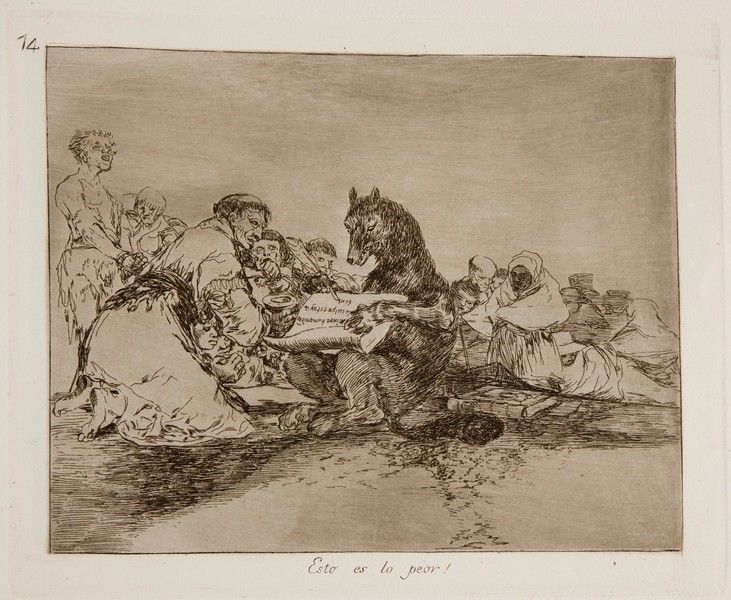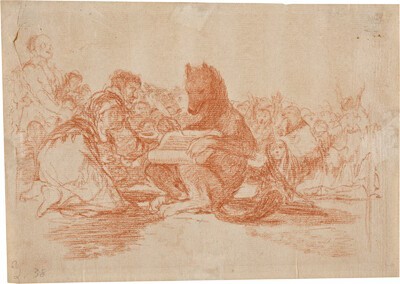- Cronología
- Ca. 1820 - 1823
- Dimensiones
- 179 x 220 mm
- Técnica y soporte
- Etching and burnisher
- Reconocimiento de la autoría de Goya
- Undisputed work
- Ficha: realización/revisión
- 03 Jan 2011 / 02 Jun 2023
- Inventario
- 225
On the sheet of paper on which the wolf writes you can read Misera humanidad la culpa es tuya. Casti.
See Sad forebodings of what is to come.
The title of the print was handwritten by Goya on the first and only series known to us at the time of its production, which the painter gave to his friend Agustín Ceán Bermúdez. Thus the title was subsequently engraved on the plate without any modification from Ceán Bermúdez's copy for the first edition of the Disasters of War published by the Royal Academy of Fine Arts of San Fernando in Madrid in 1863.
In the proof of the first state, on the verso of the folio, the black ink spotting of engraving no. 78, It defends itself well, can be seen.
A preparatory drawing of this engraving is in the Prado Museum
In a landscape, a wolf, although it has sometimes been said to be a fox, sits on its hindquarters and writes on a parchment the following sentence: Miser humanity, the fault is yours. Casti. In front of him prostrates a friar who holds the inkwell and looks at him with devotion. He is surrounded by a large group of people with emaciated faces, perhaps as a result of hunger and war. On the right of the engraving two of them are dressed in rags and one has his hands tied with a rope.
In this case there is no doubt about the influence that the text by Giambattista Casti (Viterbo or Acquapendente, 1724-Paris, 1803) Gli animali parlanti (1801) had on the creation of this print, as Goya himself wrote a fragment of this work on the paper on which he wrote the animal in the scene. Gli animali parlanti was translated into Spanish in 1813 by Francisco Rodríguez de Ledesma and published by the Espinosa press. Although only two cantos were published, according to the title of the Spanish version, the work had been translated in its entirety: Animals talking. Epic poem divided into twenty-six verses, by Juan Bautista Casti. It might also be thought that Goya had read it all in Italian, of which he must have had a discreet knowledge thanks to his stay in that country (1769-1771). This print could be a representation of a poem from Canto XXI, where Goya changed the original word for "slave" to "wretch". In Casti's text, the prime minister in charge of starting the war is a fox, who in this print could be signing a decree with the approval of the Church, symbolised in the print by the friar holding the inkwell.
If it were a wolf, Goya would be referring to the cunning and ferocity with which the rulers convinced the people that all the misfortunes that had befallen them were their fault.
The plate is in the National Chalcography (cat. 325).
-
Goya. Das Zeitalter der Revolucionen. Kunst um 1800 (1980 – 1981)Hamburger KunsthalleHamburg1980cat. 60
-
Francisco de GoyaMuseo d'Arte ModernaLugano1996exhibition celebrated from September 22nd to November 17th.cat. 74
-
Francisco Goya. Sein leben im spiegel der graphik. Fuendetodos 1746-1828 Bordeaux. 1746-1996Galerie KornfeldBern1996from November 21st 1996 to January 1997cat. 164
-
Ydioma universal: Goya en la Biblioteca NacionalBiblioteca NacionalMadrid1996from September 19th to December 15th 1996cat. 229
-
Francisco Goya. Capricci, follie e disastri della guerraSan Donato Milanese2000Opere grafiche della Fondazione Antonio Mazzottacat. 154
-
Goya et la modernitéPinacothèque de ParisParís2013from October 11st 2013 to March 16th 2014cat. 113
-
Expérience GoyaLille2021cat. 95
-
Goya, grabadorMadridBlass S.A.1918cat. 176
-
Goya engravings and lithographs, vol. I y II.OxfordBruno Cassirer1964cat. 194
-
Vie et ouvre de Francisco de GoyaParísOffice du livre1970cat. 1122
-
A solution to the enigma of Goya’s emphatic caprices nº 65-80 of The Disasters of WarApollo1978pp.186-191
-
Catálogo de las estampas de Goya en la Biblioteca NacionalMadridMinisterio de Educación y Cultura, Biblioteca Nacional1996cat. 295
-
ParísPinacoteca de París2013p. 156
-
Goya. In the Norton Simon MuseumPasadenaNorton Simon Museum2016pp. 114-151
-
Expérience Goya (cat. expo)LilleRéunion des Musées Nationaux2021pp. 169-170

